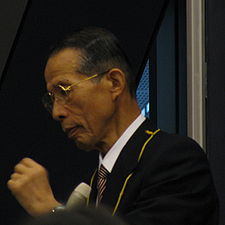- Makoto Nagao
-
Makoto Nagao 
Born October 4, 1936 Nationality Japanese Fields Computer Science Institutions Kyoto University, National Diet Library Alma mater Kyoto University Notable students Takeo Kanade, Jun'ichi Tsujii, Yuji Matsumoto, Sadao Kurohashi Known for example-based machine translation, natural language processing for Japanese, various image processing approaches, researches for digital library Notable awards IEEE Emanuel R. Piore Award,[1] ACL Lifetime Achievement Award,[2] Japan Prize[3] Makoto Nagao (長尾 真 Nagao Makoto, born October 4, 1936[3]) is a Japanese computer scientist. He contributed to various fields: machine translation, natural language processing, pattern recognition, image processing and library science. He was the 23rd President of Kyoto University,[4] and is currently the Director of National Diet Library in Japan.[5]
Contents
Biography
Born in Mie Prefecture, Japan, Makoto Nagao graduated from Kyoto University in 1959, and received a Master's degree in Engineering in 1961 and a Ph. D. in Engineering in 1966 from the university.[6] In Kyoto University, He became an assistant professor in 1967, an associate professor in 1968, and a professor in 1973.[6] He served as the 23rd President of Kyoto University (1997–2003).[4] After retirement from the university, he was appointed to the Director of National Diet Library in 2007.[5]
He held the 20th Director of the Information Processing Society of Japan (IPSJ) (1999–2000).[7] In each year from 2005, IPSJ Nagao Special Researcher Award is awarded to young Japanese computer scientists who accomplished notable research.[8]
He is the first President of the Asia-Pacific Association for Machine Translation (AAMT), and in each year from 2006, AAMT Nagao Award is awarded to individuals or groups who made contribution to machine translation.[9]
Work
Makoto Nagao is renowned as one of the first scientists who developed practical machine translation (MT) systems. Between 1982 and 1986, he led the Mu project which aimed at translations for technical papers and became the first successful MT system between English and Japanese.[2] In addition, example-based machine translation, an important approach for MT, is the method proposed by him in the early 1980s.[2]
He is also a pioneer of natural language processing (NLP) for the Japanese language. In 1994, He created KNP, a dependency analyzer for Japanese, with Sadao Kurohashi.[10][11] In 1990s, he directed a project to make a Japanese parsed corpus,[12] which is now called Kyoto University Text Corpus.[13] Another NLP resource developed under his laboratory is Juman,[14] a Japanese morphological parser and the first system which merged word segmentation and morphological analysis for languages which do not have explicit word boundaries (such as Japanese or Chinese).[2]
In pattern recognition and image processing, he was the first engineer who applied feedback analysis mechanisms to facial recognition systems, and he introduced various artificial intelligence techniques into the image processing.[3]
He supervised the Adriadne system, a digital library system, which made an impact upon digital library research in Japan and over the world.[2] While the National Diet Library of Japan holds a traditional slogan "Truth makes us free" (John 8:32), a new slogan "Through knowledge we prosper" is proposed by him as the director.[15] He is very interested in Wikipedia and gave a keynote lecture in the Wikimedia Conference Japan 2009.[16]
Honors and awards
- 1993: IEEE Emanuel R. Piore Award[1]
- 1997: Medal of Honour with Purple Ribbon[5]
- 1999: C&C Prize[17]
- 2003: ACL Lifetime Achievement Award[2]
- 2004: Professor Emeritus of Kyoto University[18]
- 2005: Japan Prize[3]
- 2005: Chevalier de la Légion d'honneur[19]
- 2008: Person of Cultural Merit[20]
References
- ^ a b "IEEE Emanuel R. Piore Award Recipients". IEEE. http://www.ieee.org/documents/piore_rl.pdf. Retrieved December 30, 2010.
- ^ a b c d e f "the Association for Computational Linguistics - 2003 ACL Lifetime Achievement Award". Association for Computational Linguistics. http://www.aclweb.org/index.php?option=com_content&task=view&id=36&Itemid=30. Retrieved 2010-03-10.
- ^ a b c d "2005(21st) JAPAN PRIZE LAUREATES". The Science and Technology Foundation of Japan. http://www.japanprize.jp/en/prize_past_2005_prize01.html. Retrieved 2010-03-20.
- ^ a b "Presidents of Kyoto University". Kyoto University. http://www.kyoto-u.ac.jp/en/profile/intro/executive/presidents/. Retrieved 2010-03-20.
- ^ a b c "Dr. Makoto Nagao appointed new Librarian of the National Diet Library". National Diet Library. http://www.ndl.go.jp/en/news/fy2007/1173394_903.html. Retrieved 2010-03-20.
- ^ a b "研究統括 長尾 真氏の略歴等" (in Japanese). Japan Science and Technology Agency. http://www.jst.go.jp/pr/report/report124/nagao.html. Retrieved 2010-03-20.
- ^ "役員・代表会員・歴代会長" (in Japanese). Information Processing Society of Japan. http://www.ipsj.or.jp/03somu/directors/s_presidents.html. Retrieved 2010-03-20.
- ^ "長尾真記念特別賞" (in Japanese). Information Processing Society of Japan. http://www.ipsj.or.jp/01kyotsu/award/nagaomakoto/index.html. Retrieved 2010-03-20.
- ^ "AAMT Nagao Award". Asia-Pacific Association for Machine Translation. http://www.aamt.info/english/nagao-e.htm. Retrieved 2010-03-20.
- ^ Sadao Kurohashi and Makoto Nagao. 1994. KN Parser : Japanese Dependency/Case Structure Analyzer. In Proceedings of the Workshop on Sharable Natural Language Resources.
- ^ http://nlp.ist.i.kyoto-u.ac.jp/EN/index.php?KNP
- ^ Sadao Kurohashi and Makoto Nagao. 1998. Building a Japanese parsed corpus while improving the parsing system. In Proceedings of the First International Conference on Language Resources and Evaluation, pages 719–724.
- ^ http://nlp.ist.i.kyoto-u.ac.jp/EN/index.php?Kyoto%20University%20Text%20Corpus
- ^ http://nlp.ist.i.kyoto-u.ac.jp/EN/index.php?JUMAN
- ^ "Greetings from the Librarian". National Diet Library. http://www.ndl.go.jp/en/aboutus/greetings.html. Retrieved 2010-03-20.
- ^ "Wikimedia Conference Japan 2009". Wikimedia Conference Japan 2009. http://www.wcj2009.info/開催概要. Retrieved 2010-03-20.
- ^ "Successive Recipients of C&C Prize". NEC C&C Foundation. http://www.candc.or.jp/en/recipient.html. Retrieved 2010-03-20.
- ^ Public Relation Section of Kyoto University (2004), "名誉教授称号授与式" (in Japanese), 京大広報 588: 1649, http://www.kyoto-u.ac.jp/notice/05_kohou/kohho/588.pdf, retrieved 2010-03-20
- ^ Public Relation Section of Kyoto University (2005), "長尾 真前総長がフランス共和国レジオン・ドヌール勲章シュバリエを受章" (in Japanese), 京大広報 600: 1894, http://www.kyoto-u.ac.jp/notice/05_kohou/kohho/600.pdf, retrieved 2010-03-20
- ^ "平成20年度 文化功労者及び文化勲章受章者について 平成20年度 文化功労者(五十音順)-文部科学省" (in Japanese). Ministry of Education, Culture, Sports, Science and Technology of Japan. http://www.mext.go.jp/b_menu/houdou/20/10/08102402/001.htm. Retrieved 2010-03-20.
Preceded by
Aravind JoshiACL Lifetime Achievement Award
2003Succeeded by
Karen Spärck JonesAcademic offices Preceded by
Hiroo ImuraPresident of Kyoto University
1997–2003Succeeded by
Kazuo OikeCategories:- 1936 births
- Living people
- Japanese computer scientists
- Japanese librarians
- Kyoto University alumni
- Kyoto University faculty
- Japan Prize laureates
- Chevaliers of the Légion d'honneur
- People from Mie Prefecture
Wikimedia Foundation. 2010.
